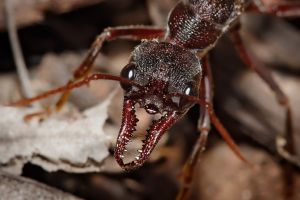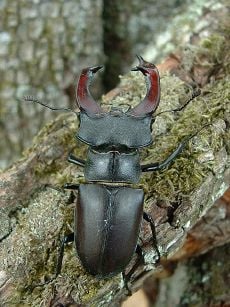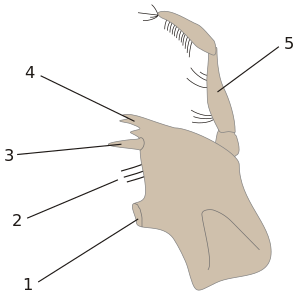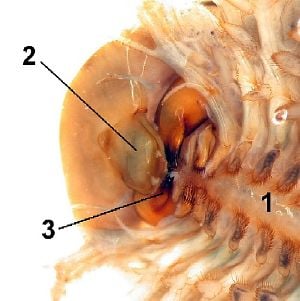Difference between revisions of "Mandibulata" - New World Encyclopedia
({{Contracted}}) |
Rick Swarts (talk | contribs) |
||
| Line 2: | Line 2: | ||
{{images OK}} | {{images OK}} | ||
| + | [[Image:Img122.jpg|The male [[dobsonfly]] has long mandibles|thumb|upright]] | ||
In arthropods, the '''mandible''' is either of a pair of [[arthropod]] [[mouthparts]] used for biting, cutting and holding food. Mandibles are often simply referred to as jaws. The arthropods with mandibles form the [[clade]] '''Mandibulata''', comprising the extant subphyla [[Myriapoda]], [[Crustacean|Crustacea]] and [[Hexapoda]]. Mandibulata is currently believed to be the sister group to the rest of arthropods, the clade [[Arachnomorpha]] ([[Chelicerata]]+[[Trilobite|Trilobita]]). The '''mandibulates''' constitute the largest and most varied arthropod group. | In arthropods, the '''mandible''' is either of a pair of [[arthropod]] [[mouthparts]] used for biting, cutting and holding food. Mandibles are often simply referred to as jaws. The arthropods with mandibles form the [[clade]] '''Mandibulata''', comprising the extant subphyla [[Myriapoda]], [[Crustacean|Crustacea]] and [[Hexapoda]]. Mandibulata is currently believed to be the sister group to the rest of arthropods, the clade [[Arachnomorpha]] ([[Chelicerata]]+[[Trilobite|Trilobita]]). The '''mandibulates''' constitute the largest and most varied arthropod group. | ||
Unlike the [[chelicerae]] of [[arachnid]]s, mandibles can often be used to chew food. Mandibulates also differ by having three distinct body regions: head, [[thorax]] and abdomen (the [[prosoma]] of chelicerates is not a fusion of head and thorax, although often called a [[cephalothorax]]). | Unlike the [[chelicerae]] of [[arachnid]]s, mandibles can often be used to chew food. Mandibulates also differ by having three distinct body regions: head, [[thorax]] and abdomen (the [[prosoma]] of chelicerates is not a fusion of head and thorax, although often called a [[cephalothorax]]). | ||
| − | == | + | |
| − | ===[[Insect]]s== | + | Margulis and Schwartz: |
| + | # Phylum Mandibulata (insects, millipedes, centipedes) | ||
| + | # Phylum Crustacea (crayfish, shrimp, copepods, isopods, and relatives) | ||
| + | Margulis, L. & Schwartz, K.V. 1998. Five Kingdoms. An Illustrated Guide to the Phyla of Life on Earth. New York: W.H. Freeman. | ||
| + | |||
| + | Mandibulata (not universally accepted) | ||
| + | D. S. Sikes. 2007. http://www.uaf.edu/museum/ento/sikes_lab/zool375web.pdf. University of Alaska Museum/University of Alaska Fairbanks. | ||
| + | |||
| + | Citation suggested: Brands, S.J. (comp.) 1989-2005. Systema Naturae 2000. Amsterdam, The Netherlands. [http://sn2000.taxonomy.nl/] | ||
| + | Subphylum Mandibulata Snodgrass, 1938 | ||
| + | H|N|P|R|B|L; Ref:®[o]D. Grimaldi & M.S. Engel, 2005:99; Count:11c;99o;1877f;13,645g;19,062s;2033ss;61v; ‡8s; †30o;80f;128g;71s;1ss | ||
| + | |||
| + | Infraphylum Crustaceomorpha (Chernyshev, 1960) | ||
| + | H|N|P|R|B|L; Ref:®[o]D. Grimaldi & M.S. Engel, 2005:99; Count:6c;47o;701f;1552g;1423s;44ss;1v; ‡1s; †9o;6f;28g;27s | ||
| + | |||
| + | Infraphylum Atelocerata | ||
| + | H|N|P|R|B|L; Ref:®[o]D. Grimaldi & M.S. Engel, 2005:99; Count:5c;52o;1176f;12,093g;17,639s;1989ss;60v; ‡7s; †21o;74f;100g;44s;1ss | ||
| + | |||
| + | Infraphylum Myriapoda (Leach, 1814) | ||
| + | H|N|P|R|B|L; Ref:®[o]Cavalier-Smith, 1998:236 | ||
| + | |||
| + | http://64.233.169.104/search?q=cache:T6PSuOxJ9C4J:cfcc.edu/rogers/courses/msc174/Lectures/Subphylum%2520Mandibulata.ppt+Mandibulata+phylum+subphylum&hl=en&ct=clnk&cd=9&gl=us&client=firefox-a | ||
| + | subphylum mandibulata | ||
| + | Jason Rogers, Cape Fear Community College | ||
| + | * All members of this group bear mandibles on the third head segment that are modified for feeding | ||
| + | * Taxonomic Summary | ||
| + | o Phylum Arthropoda | ||
| + | + Subphylum Mandibulata | ||
| + | # Class Myriapoda | ||
| + | # Class Insecta | ||
| + | # Class Crustacea | ||
| + | |||
| + | Infraphylum Insecta (Linnaeus, 1758) - insects | ||
| + | H|N|P|R|B|L; Ref:®[o]Cavalier-Smith, 1998:236 | ||
| + | |||
| + | http://64.233.169.104/search?q=cache:jkjMxbV200YJ:www.uaf.edu/museum/ento/sikes_lab/zool375web.pdf+Mandibulata+phylum+subphylum&hl=en&ct=clnk&cd=1&gl=us&client=firefox-a | ||
| + | oncept of Snodgrass 1930-1950s | ||
| + | Three classes | ||
| + | •Crustacea | ||
| + | – shrimps, lobsters, etc. 45,000 spp. | ||
| + | •Myriapoda | ||
| + | – centipedes, millipedes, 13,000 spp | ||
| + | •Insecta (Hexapoda) | ||
| + | – insects, 1,000,000+ spp. | ||
| + | |||
| + | |||
| + | |||
| + | |||
| + | |||
| + | ==[[Insect]]s== | ||
| + | [[Image:Bullant head detail.jpg|thumb|The mandibles of a Bull ant]] | ||
{{main|Mandible (insect)}} | {{main|Mandible (insect)}} | ||
Insect mandibles are as diverse in form as their food. For instance, [[grasshopper]]s and many other plant-eating insects have sharp-edged mandibles that move side to side. Most [[Lepidoptera|butterflies and moths]] lack mandibles as they mainly feed on nectar from flowers. | Insect mandibles are as diverse in form as their food. For instance, [[grasshopper]]s and many other plant-eating insects have sharp-edged mandibles that move side to side. Most [[Lepidoptera|butterflies and moths]] lack mandibles as they mainly feed on nectar from flowers. | ||
[[Queen bee]]s have mandibles with sharp cutting teeth unlike [[worker bee]]s, who have toothless jaws. Male [[Dobsonfly|dobsonflies]] have slender mandibles up to 2.5 cm long, half as long as the insect's body. [[Potter wasp]]s use their mandibles to mix droplets of water with clay while constructing a nest. | [[Queen bee]]s have mandibles with sharp cutting teeth unlike [[worker bee]]s, who have toothless jaws. Male [[Dobsonfly|dobsonflies]] have slender mandibles up to 2.5 cm long, half as long as the insect's body. [[Potter wasp]]s use their mandibles to mix droplets of water with clay while constructing a nest. | ||
| − | + | ||
| + | ===[[Ant]]s=== | ||
Ants have long, broad, serrated jaws, used for digging, collecting food, fighting and cutting, and are probably the most important work tool ants possess. Ants typically bite each other when fighting. Some ants use mandibles to injure the enemy and squirt poison into the wound. [[Harvester ant]]s use their mandibles to collect and carry seeds. [[Army ant]]s have sharp mandibles that are better adapted for fighting than obtaining food or nursing the [[larva]]e. [[Carpenter ant]]s make their nests in various wooden structures, which they hollow out with their sharp mandibles. | Ants have long, broad, serrated jaws, used for digging, collecting food, fighting and cutting, and are probably the most important work tool ants possess. Ants typically bite each other when fighting. Some ants use mandibles to injure the enemy and squirt poison into the wound. [[Harvester ant]]s use their mandibles to collect and carry seeds. [[Army ant]]s have sharp mandibles that are better adapted for fighting than obtaining food or nursing the [[larva]]e. [[Carpenter ant]]s make their nests in various wooden structures, which they hollow out with their sharp mandibles. | ||
| − | + | ||
| + | ===[[Beetle]]s=== | ||
| + | [[Image:Lucanus cervus.jpg|thumb|upright|Stag beetle with mandibles modified no longer used in feeding]] | ||
The shape and size of beetle mandibles varies from species to species depending on the food preferences. For example, [[Carnivore|carnivorous]] beetles have extended mandibles to seize or crush prey. [[Tiger beetle]]s' mandibles (similar to the piercing canine teeth of tigers) are well adapted for killing prey. [[Dytiscidae|Diving beetle]] and [[firefly]] larvae have hollow mandibles which can inject digestive fluid to [[Liquification|liquefy]] the tissues of the prey. When this process is over, they suck the digested tissue through the mandibles. | The shape and size of beetle mandibles varies from species to species depending on the food preferences. For example, [[Carnivore|carnivorous]] beetles have extended mandibles to seize or crush prey. [[Tiger beetle]]s' mandibles (similar to the piercing canine teeth of tigers) are well adapted for killing prey. [[Dytiscidae|Diving beetle]] and [[firefly]] larvae have hollow mandibles which can inject digestive fluid to [[Liquification|liquefy]] the tissues of the prey. When this process is over, they suck the digested tissue through the mandibles. | ||
| − | + | ||
| − | The [[antler]]like jaws of stag beetles are essentially their namesake trait. In some tropical species they can be up to 10 cm, as long as the body of the beetle. | + | The [[antler]]like jaws of [[stag beetles]] are essentially their namesake trait. In some tropical species they can be up to 10 cm, as long as the body of the beetle. These mandibles are primarily used in combat. |
| − | These mandibles are primarily used in combat. | + | |
| − | + | ===Butterflies and moths=== | |
[[Caterpillar]]s use sharp mandibles to cut leaves in side-to-side motions. Only a few [[moth]]s have functional mandibles in the adult stage. The most notable example are members of the family [[Micropterigidae]], small moths with toothed mandibles used for chewing [[pollen]] grains, lacking even the most rudimentary [[proboscis]]. | [[Caterpillar]]s use sharp mandibles to cut leaves in side-to-side motions. Only a few [[moth]]s have functional mandibles in the adult stage. The most notable example are members of the family [[Micropterigidae]], small moths with toothed mandibles used for chewing [[pollen]] grains, lacking even the most rudimentary [[proboscis]]. | ||
| − | + | ==[[myriapoda|Myriapods]]== | |
[[Centipede]]s have strong, bristly mandibles which have a row of teeth in all centipedes except for members of the order Geophilomorpha. Millipedes have small mandibles which are their only functioning mouthparts, as the [[Maxilla (arthropod)|maxillae]] are fused to the lower lip ([[Labium (arthropod)|labium]]). | [[Centipede]]s have strong, bristly mandibles which have a row of teeth in all centipedes except for members of the order Geophilomorpha. Millipedes have small mandibles which are their only functioning mouthparts, as the [[Maxilla (arthropod)|maxillae]] are fused to the lower lip ([[Labium (arthropod)|labium]]). | ||
| − | + | ||
| + | ==[[Crustacean]]s== | ||
| + | [[Image:Mandible.svg|[[Amphipoda|Amphipod]] mandible diagram|thumb]] | ||
| + | [[Image:Mouthparts.jpg|Head of a [[Triops longicaudatus|tadpole shrimp]], with the mandibles labelled 3|thumb]] | ||
Crustaceans have a pair of mandibles that typically consist of an enlarged basal segment (coxa) and a [[palp]] (sensory feeler) consisting of all other segments. In some groups, such as the [[Branchiopoda]], the palp is reduced or absent. Crustacean mandibles may be equipped with special teeth (molar and incisor processes). | Crustaceans have a pair of mandibles that typically consist of an enlarged basal segment (coxa) and a [[palp]] (sensory feeler) consisting of all other segments. In some groups, such as the [[Branchiopoda]], the palp is reduced or absent. Crustacean mandibles may be equipped with special teeth (molar and incisor processes). | ||
| − | |||
| − | |||
| − | |||
| − | |||
| − | |||
| − | |||
| − | |||
| − | |||
| − | |||
| − | |||
| − | |||
| − | |||
| − | |||
| − | |||
| − | |||
| − | |||
| Line 49: | Line 90: | ||
[[Category:Insects]] | [[Category:Insects]] | ||
| − | {{ | + | {{credit|Mandible_(arthropod)|176879461}} |
Revision as of 22:24, 13 December 2007
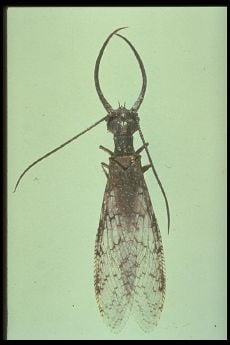
In arthropods, the mandible is either of a pair of arthropod mouthparts used for biting, cutting and holding food. Mandibles are often simply referred to as jaws. The arthropods with mandibles form the clade Mandibulata, comprising the extant subphyla Myriapoda, Crustacea and Hexapoda. Mandibulata is currently believed to be the sister group to the rest of arthropods, the clade Arachnomorpha (Chelicerata+Trilobita). The mandibulates constitute the largest and most varied arthropod group.
Unlike the chelicerae of arachnids, mandibles can often be used to chew food. Mandibulates also differ by having three distinct body regions: head, thorax and abdomen (the prosoma of chelicerates is not a fusion of head and thorax, although often called a cephalothorax).
Margulis and Schwartz:
- Phylum Mandibulata (insects, millipedes, centipedes)
- Phylum Crustacea (crayfish, shrimp, copepods, isopods, and relatives)
Margulis, L. & Schwartz, K.V. 1998. Five Kingdoms. An Illustrated Guide to the Phyla of Life on Earth. New York: W.H. Freeman.
Mandibulata (not universally accepted) D. S. Sikes. 2007. http://www.uaf.edu/museum/ento/sikes_lab/zool375web.pdf. University of Alaska Museum/University of Alaska Fairbanks.
Citation suggested: Brands, S.J. (comp.) 1989-2005. Systema Naturae 2000. Amsterdam, The Netherlands. [1] Subphylum Mandibulata Snodgrass, 1938
H|N|P|R|B|L; Ref:®[o]D. Grimaldi & M.S. Engel, 2005:99; Count:11c;99o;1877f;13,645g;19,062s;2033ss;61v; ‡8s; †30o;80f;128g;71s;1ss
Infraphylum Crustaceomorpha (Chernyshev, 1960)
H|N|P|R|B|L; Ref:®[o]D. Grimaldi & M.S. Engel, 2005:99; Count:6c;47o;701f;1552g;1423s;44ss;1v; ‡1s; †9o;6f;28g;27s
Infraphylum Atelocerata
H|N|P|R|B|L; Ref:®[o]D. Grimaldi & M.S. Engel, 2005:99; Count:5c;52o;1176f;12,093g;17,639s;1989ss;60v; ‡7s; †21o;74f;100g;44s;1ss
Infraphylum Myriapoda (Leach, 1814)
H|N|P|R|B|L; Ref:®[o]Cavalier-Smith, 1998:236
http://64.233.169.104/search?q=cache:T6PSuOxJ9C4J:cfcc.edu/rogers/courses/msc174/Lectures/Subphylum%2520Mandibulata.ppt+Mandibulata+phylum+subphylum&hl=en&ct=clnk&cd=9&gl=us&client=firefox-a subphylum mandibulata Jason Rogers, Cape Fear Community College
* All members of this group bear mandibles on the third head segment that are modified for feeding
* Taxonomic Summary
o Phylum Arthropoda
+ Subphylum Mandibulata
# Class Myriapoda
# Class Insecta
# Class Crustacea
Infraphylum Insecta (Linnaeus, 1758) - insects
H|N|P|R|B|L; Ref:®[o]Cavalier-Smith, 1998:236
http://64.233.169.104/search?q=cache:jkjMxbV200YJ:www.uaf.edu/museum/ento/sikes_lab/zool375web.pdf+Mandibulata+phylum+subphylum&hl=en&ct=clnk&cd=1&gl=us&client=firefox-a oncept of Snodgrass 1930-1950s Three classes •Crustacea – shrimps, lobsters, etc. 45,000 spp. •Myriapoda – centipedes, millipedes, 13,000 spp •Insecta (Hexapoda) – insects, 1,000,000+ spp.
Insects
Insect mandibles are as diverse in form as their food. For instance, grasshoppers and many other plant-eating insects have sharp-edged mandibles that move side to side. Most butterflies and moths lack mandibles as they mainly feed on nectar from flowers.
Queen bees have mandibles with sharp cutting teeth unlike worker bees, who have toothless jaws. Male dobsonflies have slender mandibles up to 2.5 cm long, half as long as the insect's body. Potter wasps use their mandibles to mix droplets of water with clay while constructing a nest.
Ants
Ants have long, broad, serrated jaws, used for digging, collecting food, fighting and cutting, and are probably the most important work tool ants possess. Ants typically bite each other when fighting. Some ants use mandibles to injure the enemy and squirt poison into the wound. Harvester ants use their mandibles to collect and carry seeds. Army ants have sharp mandibles that are better adapted for fighting than obtaining food or nursing the larvae. Carpenter ants make their nests in various wooden structures, which they hollow out with their sharp mandibles.
Beetles
The shape and size of beetle mandibles varies from species to species depending on the food preferences. For example, carnivorous beetles have extended mandibles to seize or crush prey. Tiger beetles' mandibles (similar to the piercing canine teeth of tigers) are well adapted for killing prey. Diving beetle and firefly larvae have hollow mandibles which can inject digestive fluid to liquefy the tissues of the prey. When this process is over, they suck the digested tissue through the mandibles.
The antlerlike jaws of stag beetles are essentially their namesake trait. In some tropical species they can be up to 10 cm, as long as the body of the beetle. These mandibles are primarily used in combat.
Butterflies and moths
Caterpillars use sharp mandibles to cut leaves in side-to-side motions. Only a few moths have functional mandibles in the adult stage. The most notable example are members of the family Micropterigidae, small moths with toothed mandibles used for chewing pollen grains, lacking even the most rudimentary proboscis.
Myriapods
Centipedes have strong, bristly mandibles which have a row of teeth in all centipedes except for members of the order Geophilomorpha. Millipedes have small mandibles which are their only functioning mouthparts, as the maxillae are fused to the lower lip (labium).
Crustaceans
Crustaceans have a pair of mandibles that typically consist of an enlarged basal segment (coxa) and a palp (sensory feeler) consisting of all other segments. In some groups, such as the Branchiopoda, the palp is reduced or absent. Crustacean mandibles may be equipped with special teeth (molar and incisor processes).
Credits
New World Encyclopedia writers and editors rewrote and completed the Wikipedia article in accordance with New World Encyclopedia standards. This article abides by terms of the Creative Commons CC-by-sa 3.0 License (CC-by-sa), which may be used and disseminated with proper attribution. Credit is due under the terms of this license that can reference both the New World Encyclopedia contributors and the selfless volunteer contributors of the Wikimedia Foundation. To cite this article click here for a list of acceptable citing formats.The history of earlier contributions by wikipedians is accessible to researchers here:
The history of this article since it was imported to New World Encyclopedia:
Note: Some restrictions may apply to use of individual images which are separately licensed.
